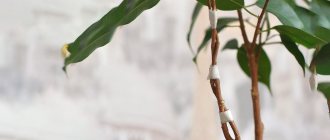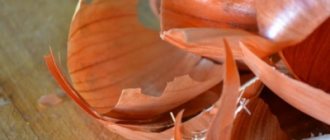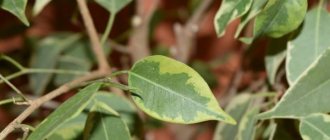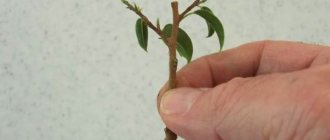Ficus is a fairly popular indoor plant. Most often you can find Ficus Benjamin in homes and offices. It does not require special growing conditions, which is why it is so loved. But in order to maintain its decorative qualities, you need to provide it with adequate nutrition. Properly selected fertilizers for Ficus Benjamin and timely fertilizing will help preserve the beauty of the plant.
Conditions for proper development
Ficus benjamina feels good in a spacious pot. This does not mean that you need to immediately plant it in a flowerpot, you just need a pot where the plant will freely take root. At the same time, the ficus does not like frequent transplants and changes of place of residence; for this it needs constancy. He reacts to all changes with protest - he sheds his leaves.
The plant needs moderate watering, always with warm, settled water. Excess moisture and low temperatures lead to rotting of the roots. Therefore, excess water that has flowed into the pan must be drained immediately.
The shower for Ficus Benjamin should also be warm, and after that the leaves should be wiped with a damp cloth. Otherwise, dusty stains will remain on the leaves, and the plant does not like this.
Why do plant leaves turn yellow and fall off and what to do?
Season change
Changing seasons can actually cause leaf loss.
As with “wild” plants, this happens extremely rarely in the summer, and here you need to be wary and find out if your pet is healthy, or if there are other reasons for “leaf fall”? Another thing is autumn and winter. In the wild, ficus trees grow in tropical areas where there is enough warmth and sun, regardless of the time of year. There is approximately 14 hours of daylight all year round.
With the onset of autumn, lighting in our houses and apartments begins to decrease and reaches its minimum in winter. To this you can almost always add hot dry air from hot heating radiators and the cold sill of a plastic window. The flower perceives these changes as the beginning of a period of rest and, as in the wild, gets rid of leaves.
This is a natural process, and new young leaves immediately grow in place of the lost ones. This happens especially intensely with the onset of spring, when instead of one lost one, three new ones appear.
If the loss of leaves exceeds 20% of their volume, this indicates other reasons for what is happening: improper care, pests or plant disease.
Change of place
Another provoking factor is a change in the location of the plant. Moreover, this can be not only a move from a flower shop to a permanent place of residence, but also a transfer from one room to another, a move from the back of a room to a windowsill, and even just a rotation around its axis!
In a new place, the ficus experiences severe stress and reacts to it by shedding its leaves. The situation can become more complicated if you transplant or prune the plant immediately after purchase.
Incorrect temperature conditions and drafts
Like any tropical plant, Ficus Benjamina is quite thermophilic. The room temperature in spring and summer should be within 25-27°C, in autumn and winter – 16-18°C.
But if it changes above the recommended values, the leaves of the tree will dry out and fall off. A heating radiator in winter can dry and heat the air in a room, lowering the humidity to 25%, like in the desert. In this case, not only old leaves, but also young ones can fall off.
Leaf fall is guaranteed to begin even when the pot freezes on a cold windowsill or floor. Even a small draft will also negatively affect the development of the flower.
Mistakes when watering
A common cause of leaf shedding is insufficient watering. This is a protective reaction of the plant when there is a lack of moisture. The same thing can happen when watering a plant with cold water.
Excessive moistening of the earthen coma is even more dangerous. In this case, not only the foliage will suffer, but also the roots of the plant. And then it will be almost impossible to save him. Overwatering is especially dangerous in autumn and winter. Indeed, in tropical conditions, at this time a period of drought begins, and the tree, which receives abundant watering, experiences stress.
Fertilizer shortage
Another cause of plant disease is soil depletion. If the plant has not been replanted for a long time or the soil has not been updated, then there will be a lack of nutrients. Without receiving enough essential minerals and trace elements, the ficus will begin to lose foliage.
Diseases and pests
One of the most common causes of leaf loss in Ficus Benjamin is infection with spider mites and thrips. These are small insects that feed on plant cell sap.
- Thrips infestation causes yellow or discolored spots to appear on the leaves, followed by holes.
- Spider mites form small white dots and envelop the affected plant in cobwebs.
Both pests cause not only the loss of leaves, but also the death of the plant.
Incorrect flower placement
In order for your tree to delight you with a lush crown, you need to choose a convenient place for it.
Ficus should not be placed under burning sun rays or in dense shade.
There should be no drafts or hot radiator in this place. It is best to place the plant close to a well-lit window.
Nutrition needed by ficus and signs of its deficiency
To know exactly what fertilizers are needed for Ficus Benjamin, you need to understand what the ficus eats.
For the proper development of a plant, it needs various macro- and microelements. There are 13 of them in total, nitrogen is considered the main one. It is nitrogen that forms the green mass and is responsible for the rich color of the leaves. Thanks to it, photosynthetic processes proceed normally.
Ficus also needs:
- In phosphorus, thanks to which the root system of the plant grows and develops and resistance to diseases increases.
- Potassium, thanks to which the plant tolerates short-term droughts well.
- Calcium, which improves the metabolic processes of the flower.
These are the main elements; additional elements include magnesium, manganese, sulfur, iron, zinc, copper, molybdenum, cobalt, and boron.
When the soil begins to lack certain nutrients, the flower starves. This can be seen by the following signs:
- Growth slows down and then stops completely.
- The stems stretch and become thin.
- The leaves become pale and yellow spots appear.
- The elasticity of the leaves is lost, they can dry out and die.
- The plant's immune system begins to work poorly, so susceptibility to disease increases.
- Low resistance to pests.
Feeding Ficus Benjamin should be done regularly until the above signs begin to appear.
The ficus will also react to excessive fertilization: it will shed its leaves and the soil will become covered with a white coating.
Reason #2. Lack of light
The ability of Ficus Benjamin to tolerate shading is determined by the variety: green-leaved ficuses are quite hardy and can withstand slight shading, while variegated ones will not retain their color if there is a lack of light. But even the most persistent ficuses, accustomed from a young age to secluded lighting, will not be able to take root only in artificial lighting and in the back of rooms. The maximum shading they can withstand is light partial shade.
Ficuses are especially sensitive to insufficient lighting in winter, when plants need to be moved closer to windows. Before the partial shedding of leaves begins, the ficuses stretch out, become smaller, and lose color, but if the first signals were ignored, damage to the leaf mass will not occur.
How to fix the problem:
- move the ficus closer to the window;
- move to a brighter room with windows facing south;
- organize additional lighting.
Benjamin's ficuses really don't like hot and dry air from heating appliances. © Maja Dumat
How to properly feed ficus benjamina
Fertilizers are needed for the active growth and development of the plant. This is especially important during the growing season.
In summer, the flower needs to be fed with nitrogen-containing fertilizer. After this, the growth of deciduous mass will begin. This feeding is also suitable for rehabilitating a damaged plant.
Since this flower is quite tall (at home it grows up to 3 meters), fertilizers for Ficus Benjamin should be varied. You can purchase ready-made fertilizers in specialized stores or prepare them yourself at home.
Before feeding, you need to make sure that the ficus does not become crowded in the pot. As usual, it is replanted once every 4 years, when the roots completely entangle the soil in the pot. It is best to replant ficus in spring or autumn when it is warm.
It is not necessary to prepare the soil for replanting yourself; it is easier to purchase a special soil mixture for ficuses in the store. In special soil the plant will take root faster.
Fertilizers for Ficus Benjamin will depend on several factors: soil, age of the plant, season. For example, if the substrate does not contain soil, it means that it contains absolutely no nutrients, and in this case, fertilizing is carried out all year round. Conventional soil mixtures are periodically fed with organic or mineral fertilizers. As a rule, fertilizing is carried out in the summer, every two weeks.
Organize water treatments
Ficus benjamina needs regular spraying. During the cold season, when heating appliances are on in the room and the air is dry, the procedure is especially necessary for tropical plants. It is recommended to spray the tree 2-3 times during the day using a fine spray bottle. It should be kept at a distance of 20 cm from the foliage.
Decorative culture also responds well to a warm shower. It reduces the risk of plant damage by mites. On the eve of the water procedure, you can wipe the leaf plates with soapy water or ash infusion.
How often to feed ficus
Fertilizing ficus benjamina at home is not done as often as other house flowers. But at the same time, the amount of nutrients should be sufficient for proper nutrition.
The larger the plant's canopy, the more nutrients it will need. In about two months, the ficus completely depletes the soil.
Intensive feeding will be required during the active growth of the plant - in the spring and summer.
The last time fertilizing ficus at home is carried out at the end of September. When cold weather sets in, the ficus goes into a dormant state and all processes slow down. The need for nutrition is reduced; there is no need to fertilize it during this period.
If the room where the ficus is grown is warm and light enough, fertilizing can be continued, but the rate and frequency must be reduced.
Keep away from drafts, hot radiators and direct sunlight
Shedding of foliage can be caused by exposure of ficus benjamina to drafts. The pot should be kept away from window openings.
If the plant is hot, the ficus may also shed its leaves. He also does not tolerate the cold well. Hypothermia of the roots negatively affects the condition of the crown. The tree should not be left on window sills, stone or marble floors. Leaves should not come into contact with cold window glass during the winter months.
Ficus Benjamin does not tolerate being near a radiator due to intolerance to heat and dry air. Its leaves begin to fall.
Crown thinning is also caused by a lack of light. You can solve the problem by moving the pot to a well-lit place. However, direct sunlight on the foliage should be avoided. There is a risk of the plant getting burned.
What kind of fertilizers are there for ficus benjamina?
Based on their origin, fertilizers are divided into two main types: mineral and organic.
Mineral fertilizers are inorganic compounds that are produced industrially. They contain a very high concentration of useful substances, which means they will give a positive effect faster.
Organic fertilizers are the decomposing remains of plant and animal organisms. They nourish plants well, improve soil, and improve the functioning of beneficial microorganisms, but their action is slower.
The best fertilizer for Ficus Benjamin is alternating mineral and organic fertilizers. This approach will provide the flower with the necessary nutrition for full development.
Reason #5. Too long droughts
Ficus benjamina can forgive several missed waterings and short-term drying out of the soil. But if the problems are repeated constantly, the plant is left with a completely dry substrate for several days, the ficus will inevitably begin to shed its leaves.
How to fix the problem:
- use automatic watering systems;
- monitor the degree of drying of the soil, preventing it from drying out completely;
- Water your plants more regularly and delegate watering to friends while you’re away.
With a completely dry substrate, Benjamin's ficus will inevitably begin to shed its leaves.
Mineral fertilizers
Today there are quite a few different fertilizers specifically for Ficus Benjamin. They contain minerals in the right ratio.
All drugs differ in the form of release:
- Dry - in powder, tablets, granules. Solutions are prepared from them or placed in the soil. In the latter case, they gradually dissolve when watered.
- Liquid - they are used to carry out root and foliar treatment of plants. They are distinguished by their fast action.
- Sticks - they are loved for their prolonged action (up to several months). Place next to a flower in a pot. Allows you to save time on caring for the plant.
Check for diseases
If spots and damage appear on the leaf blades, over time the foliage begins to turn yellow and crumble, the cause of this may be fungal infections such as powdery mildew and other diseases or insect pests. Among the parasites that harm Ficus Benjamin are:
- aphids;
- spider mite;
- scale insect;
- mealybug.
Often, diseases and insect damage are provoked by violation of the rules of care, in particular, waterlogging of the soil.
If it is discovered that Benjamin’s ficus has suffered from a fungal infection or parasitic insects, take immediate action:
- remove infected foliage;
- the plant is treated with special purchased preparations;
- apply chemicals again after a few days to achieve a better effect.
Sometimes foliage falls due to a lack of certain substances in the plant:
- iron (the use of Ferrovit or iron chelate will help solve the problem);
- magnesium (manifested by yellowing and falling of the lower leaves, can be solved by applying fertilizers such as magnesium sulfate, potassium magnesium, dolomite flour).
The most popular fertilizers for ficus that are easy to use at home
- Humus of animal origin is a natural source of nitrogen. It is this fertilizer that is used for ficus benjamina to thicken the leaves. The most beneficial substances are found in bird droppings. Bird droppings products are even superior to manure. They act very quickly, almost like mineral fertilizers. It must be remembered that bird droppings are used only in the form of a solution. Ficus Benjamin can be fed with humus from the manure of cattle, horses, pigs, etc. It is also used in the form of a solution.
- Plant humus - in this case, plant debris decomposes. This fertilizer has many essential microelements, and a solution is also made from it.
- Nettle. Nettle fertilizer contains elements such as nitrogen, potassium and magnesium. It is used to strengthen the root system, accelerate plant development, and improve soil condition. Leaves and stems must be prepared in advance, before the seeds appear on the nettles. Fill half a plastic bottle with nettles, add water and leave to ferment for 2 weeks. The result is a dark green liquid, which is diluted with water for use. Ficus should be watered with a solution in a ratio of 1:10, and sprayed with a solution of 1:20. The proportions should not be violated, as you can burn the leaves and roots.
- Wood ash. It contains quite a lot of different elements, including potassium and phosphorus. An infusion is made from ficus ash: 1 tsp. ash is poured into 1 liter of boiling water and left for 7 days. This infusion is used to water the flower. Also, to protect the plant from pests, you can dust the leaves with ash.
- Succinic acid. If Benjamin's ficus sheds its leaves, fertilizer is usually not required for it; this is a reaction of the flower to external stimuli, such as frequent replanting, change of residence or improper care. If there have been no changes in the life of the flower, you can feed it with a crystalline colorless substance - succinic acid. It promotes flower growth, increases its vitality, and improves soil microflora. To fertilize, you first need to prepare a concentrate: dissolve 1 g of succinic acid in 1 liter of water. For spraying leaves, this concentrate is diluted with water in a ratio of 1:1, for root watering - in a ratio of 1:4. It is recommended to feed ficus with succinic acid once a year; the finished concentrated liquid is stored for no more than 3 days.
Thus, fertilizers for Ficus Benjamin at home can be completely different, the main thing is to accurately observe the proportions when using them.
When the leaves turn yellow (after transplantation, in winter, summer, spring)
Sometimes, even with careful care, a handsome evergreen may face the threat of yellowing. This is partly due to the natural feature of the flower: the leaves enter a period of renewal every three years, a process accompanied by yellowing and shedding.
If abscission occurs en masse, you should take a closer look at the possible reasons:
- During replanting, unsuitable or unhealthy soil composition was selected;
- the pot is not the right size (both small and overly spacious can cause harm);
- The flower was watered immediately after transplantation.
It is not too late to fix the problem if no more than 2 weeks have passed since replanting, returning the plant to its previously inhabited place.
It is important to remember that flowers do not like to change their place of residence: be careful when moving them to new containers and soils.
Before watering, it is better to check the soil with a stick or your own finger to determine the need for further moistening. If excess water cannot be avoided, stop watering completely over the next 2 weeks. In the most severe cases, you will need to trim the rotten roots and then replant.
Excess moisture is the most common cause of yellowing foliage.
Representatives of the Tutovs prefer bright, warm places, devoid of the slightest through breezes. Cold air and lack of light easily cause yellowing of foliage.
As the processes of “baldness” are eliminated, you can use special means to stimulate growth. Treatment with “Epin” or “Zircon” will revive your pet and delight you with the growth of fresh greenery.
Root feeding
Root feeding is watering the plant with nutrient solutions and is the most common method. But in order not to harm the plant, this procedure must be carried out wisely. It will benefit the flower if you adhere to the following rules:
- Read the manufacturer's instructions and follow them exactly. The dosage can be adjusted according to the appearance of the ficus.
- Sick plants do not need to be fed - in this state they do not absorb nutrients. The flower must first be treated with fungicides and wait until it has fully recovered.
- It is not recommended to feed the ficus immediately after transplantation; you need to wait 20-30 days for the plant to adapt and restore damaged roots.
- To prevent burns to the ficus root system, all fertilizing is applied only to moist soil.
Fertilizers for root feeding can be different: both dry and liquid. It is important that the composition is evenly distributed throughout the pot so that all roots receive nutrition.
Reason #8. Imbalance of substances
Ficus plants are decorative deciduous plants that require a special ratio of microelements. Their needs can only be met by complex-component fertilizers with a slightly higher proportion of nitrogen and all microelements (iron, molybdenum, copper, manganese, calcium, zinc).
How to fix the problem:
- choose special fertilizers for ficus trees or at least decorative deciduous plants;
- do not experiment with homemade fertilizers and organics with untested characteristics;
- use fertilizers strictly according to the instructions, without increasing the frequency or concentration.
The needs of ficus benjamina can only be satisfied by complex-component fertilizers
Foliar feeding
Ficus plants also love foliar feeding. Through the leaves, nutrients are absorbed faster by plants. Often, foliar treatment is used in emergency cases when the roots cannot take nutrition from the soil. This procedure works very quickly, and the result is visible immediately. But solutions for spraying leaves are very weak, so they cannot completely replace the main feeding.
To maximize the effect of the treatment, it is important to carry it out correctly. The leaves need to be sprayed with a spray bottle, always on both sides. At the bottom of the leaf there are more stomata, through which the fertilizer will be absorbed.
It is very important to prepare the solution for treatment correctly, that is, not to exceed the recommended dosage. Fertilizer can burn the leaves, then the ficus will get sick and die.











